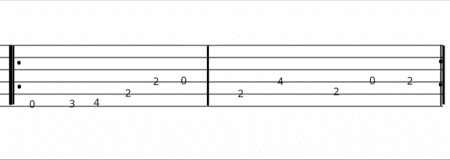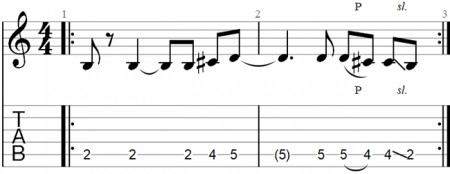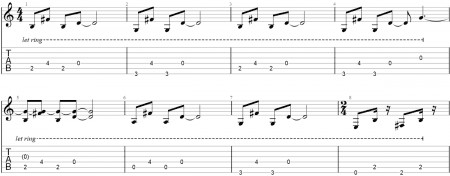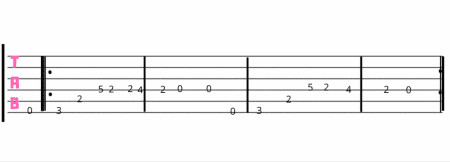Playing riffs on the guitar might seem daunting for beginners, regardless of when you decide to start your guitar journey. The term “riff” itself can sound technical, and hearing experienced players execute rapid-fire note sequences can be intimidating. Especially those riffs that are played at high speeds.
However, learning guitar riffs, even on an acoustic guitar, is an incredibly effective way to develop essential guitar techniques and learn songs more quickly. There’s a wealth of easy guitar riffs perfect for beginners, serving as a stepping stone to more complex pieces and electric guitar riffs.
Decoding Guitar Riffs
To truly master guitar riffs, understanding what they are is crucial. At its core, a guitar riff is a short, repeated musical phrase or pattern. Think of it often as the catchy hook or chorus of a song.
Fundamentally, a riff is a distinct musical idea presented in a soloistic manner. This pattern can be built from chords or individual notes. Riffs can be played in the lower register of the guitar, acting as a rhythmic foundation, or higher up the neck as a lead guitar element.
Depending on your skill level and the context, guitar riffs can be played with a clean tone or enhanced with effects. Often, the main riff of a song is a solo riff that becomes instantly recognizable.
As your riff-playing skills progress, you’ll naturally be drawn to more advanced techniques, eventually tackling longer and more intricate guitar solos.
You might also encounter the term “guitar lick” used interchangeably with “guitar riff.” While closely related, the distinction often lies in their melodic function.
If the musical phrase is integral to the song’s main theme or chorus, it’s generally considered a riff. However, if a solo passage is more of a melodic improvisation or embellishment, it’s often referred to as a lick.
Finding the Right Chords for Your Riff
To effectively craft or learn a guitar riff, understanding the underlying musical scale is key. Often, you’ll be learning riffs from existing songs, making it easier to stick to the song’s original key and scale.
However, you can also explore chord variations based on related keys within the same scale. A solid understanding of scales allows for experimentation and finding chords that complement the riff.
When choosing chords, prioritize those that offer a variety of notes to draw from. For instance, in the G Major Scale, G is the root note, and you can readily start building your riff around it.
The most suitable chord will typically be the one containing the most notes that naturally occur within a section of your riff – these are known as chord tones. Each section of a riff has chord tones that suggest the most harmonious chord choices.
Experimenting with different chords and identifying those you can play comfortably and transition between smoothly is an excellent way to begin and build familiarity with riffs.
You can even start by finding a sequence of individual notes that feel comfortable and use that as the foundation for developing your riffs.
The Importance of Guitar Riffs
Learning easy guitar riffs from popular songs offers immediate rewards and a significant boost to your guitar journey. Successfully playing recognizable riffs is instantly impressive and builds confidence in your growing guitar skills.
Instead of monotonous exercises, learning riffs becomes a fun and engaging practice method. Riffs naturally incorporate essential guitar techniques like finger placement, picking accuracy, and smooth transitions between chords and positions. They are practical exercises disguised as cool musical phrases.
Here are 10 uncomplicated guitar riffs, complete with guitar tabs, specifically chosen for new guitarists to learn and master. These beginner-friendly riffs will equip you with foundational guitar chords and songs, setting you firmly on the path to becoming a proficient guitarist.
Note Riffs vs. Chord Riffs
Guitar riffs can be constructed entirely from chords, solely from individual notes, or a blend of both. Deciding where to begin can be tricky. If you’re starting out and find yourself more comfortable with strumming full chords or picking individual notes, let that guide your initial riff choices.
It’s important to challenge yourself. Once you feel confident with either chord-based or note-based riffs, venture into the more complex patterns that combine both. Consistent practice is the key to improvement. Playing along with the original songs as you learn these classic riffs is also highly recommended. This allows you to test your memory, timing, and coordination in a musical context.
10 Beginner-Friendly Guitar Riffs
1. “Come As You Are” by Nirvana
 DAY TRIPPER by The Beatles
DAY TRIPPER by The Beatles
“Come As You Are” is an excellent starting point due to its simplicity and the fact that the entire intro riff is played on the lower strings – the low E and A strings on your acoustic or electric guitar. For the original tuning, these strings are tuned down a whole step to D and G respectively, but for learning purposes standard tuning works perfectly well. Using a chorus pedal on an electric guitar will replicate the iconic sound of the original recording.
This riff is a two-bar phrase and begins with three eighth-note pickups (D, D, D#). The full notes played are D, D#, E, G, and A, alternating between open, first, and second fret positions.
A helpful tip for learning riffs, especially if you are familiar with the song, is to play along with the recording. This can significantly aid in grasping the rhythm and feel of the riff. For faster riffs, it might be beneficial to practice slowly without the music initially until you become comfortable with the finger movements and transitions.
As you progress with learning riffs, try practicing with your eyes closed. This technique enhances your tactile sense, allowing you to feel finger placement and string picking by touch rather than relying solely on sight. This adds another layer of refinement to your guitar technique.
2. “Day Tripper” by The Beatles
“Day Tripper” is undeniably one of the easiest guitar riffs for beginners, making it essential for this list. John Lennon’s genius for crafting simple yet incredibly catchy melodies is on full display here. This riff translates beautifully to both electric and acoustic guitar without losing its impact.
The riff, based on the E minor pentatonic scale, consists of two bars repeated throughout the song. Learning this riff is a fantastic way to familiarize yourself with the minor pentatonic scale, with notes played primarily on the thickest 6th, 5th, and 4th strings.
“Day Tripper” is also a rewarding riff to learn because mastering it essentially unlocks the entire song’s structure.
The notes in the first bar are played in the sequence E, G, G#, B, E, D, and the second bar follows with B, F#, B, D, E.
3. “Paranoid” by Black Sabbath
 I CAN'T GET NO SATISFACTION by The Rolling Stones
I CAN'T GET NO SATISFACTION by The Rolling Stones
“Paranoid” features a quintessential classic rock riff that’s remarkably easy to pick up. Many experienced guitarists likely started their riff-playing journey with this iconic track. The initial hammer-ons in the first bar are quite rapid, so practicing hand coordination is key to picking the strings accurately before executing the hammer-on to the fourteenth fret.
Listening to the song repeatedly will solidify your understanding of the rhythm. Start practicing at a slower tempo and gradually increase the speed as your confidence and accuracy grow.
4. “(I Can’t Get No) Satisfaction” by The Rolling Stones
This universally recognized song boasts a fantastic riff for beginner guitarists because it utilizes only three notes on a single string. You’ll use your first, third, and fourth fingers to play these notes, making it a straightforward riff to grasp.
When first learning this riff, don’t be overly concerned with incorporating slides and pull-offs immediately. Focus on accurately picking each note and getting accustomed to the rhythm. Once comfortable, you can then introduce those subtle nuances to enhance the riff and bring it closer to the original sound.
5. “Smoke on the Water” by Deep Purple
Alt text: Advanced guitar tab for “Smoke on the Water” by Deep Purple, demonstrating fretted note control.
“Smoke on the Water” is a classic, instantly recognizable guitar riff that’s also surprisingly easy to play. However, it’s often misplayed due to the common simplified notation of 0-3-5. For beginners, a simplified version using open strings, without slides, is a great starting point.
More advanced players typically perform the original version, which includes slides and fretted notes.
Both versions sound similar, but as your skills develop, you’ll appreciate the greater control over tone and articulation that fretted notes offer compared to open strings, even though open strings are initially easier for beginners.
6. “Back in Black” by AC/DC
AC/DC is renowned for their high-energy rock anthems packed with memorable guitar riffs. “Back in Black,” one of their biggest hits, features an excellent riff for beginners, heavily reliant on power chords. Start by focusing solely on mastering the power chords before incorporating the single notes into the riff.
Maintaining a solid, driving rhythm is paramount when playing this riff. In heavy metal and rock music, guitar riffs often function as a rhythmic backbone, making precise timing essential.
7. “One” by Metallica
 ONE by Metallica
ONE by Metallica
Metallica, another giant of heavy metal, offers a wealth of accessible riffs for learners. “One” features a beginner-friendly riff that is deliberately slow, allowing ample time to articulate each note clearly. When playing this riff, ensure each note rings out distinctly by avoiding accidental muting of adjacent strings.
The intro riff from Metallica’s “Fade To Black” shares similar finger patterns and can be practiced alongside “One.” Experiment with different fingerings to discover what feels most comfortable and efficient for you.
8. “Redemption Song” by Bob Marley
This timeless song, rooted in reggae, is perfectly suited for acoustic guitar. Originally played in the key of G, this simple four-bar riff utilizes the G major scale. Familiarity with major chords like G, C, D, and E is beneficial when learning this riff. The notes in the first bar are G, A, B, G, and the second bar contains C, E, D, B.
9. “Beat It” by Michael Jackson featuring Eddie Van Halen
 BEAT IT by Michael Jackson featuring Eddie Van Halen
BEAT IT by Michael Jackson featuring Eddie Van Halen
This iconic riff, spanning four bars, is ideally played on electric guitar with a distortion effect to capture the original song’s vibe. The notes for the riff are G, B, G, E, F# for the first bar, followed by E, D, D, E for the second bar. The third bar repeats the first, and the fourth bar concludes with E, D.
The riff includes a slide down to G on the third fret of the 6th string at the beginning of the first bar, and another slide on E at the second fret of the 4th string in the second bar.
10. “Seven Nation Army” by The White Stripes
This final riff offers an easy-to-follow guitar tab and works equally well on electric or acoustic guitar. While the original song uses Open A tuning, you can play this riff in standard tuning and still achieve a sound very close to the original.
The main riff, repeated throughout the song, is straightforward and impactful.
These ten guitar riffs are all designed to be accessible for beginner guitarists. Some may be learned quickly, while others might require more practice. The provided guitar tabs are a valuable resource, and supplementing your learning with video lessons on platforms like YouTube can be incredibly helpful. Video lessons often provide visual guidance on finger placement and riff execution.
Consider exploring other easy guitar songs to expand your repertoire. Taking guitar lessons, either in person or online, with a qualified instructor can also significantly accelerate your progress in mastering guitar riffs and overall guitar playing.
With consistent practice and dedicated learning, you’ll soon be playing these famous songs and their incredible guitar riffs. You’ll impress your friends and confidently claim your status as a guitar player. Keep riffing!
